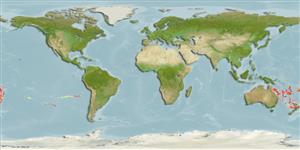Environment: milieu / climate zone / depth range / distribution range
Écologie
marin benthopélagique; profondeur 230 - 920 m (Ref. 86942). Deep-water; 13°S - 40°S, 143°E - 83°W (Ref. 6181)
Southeast Pacific: seamounts of Nazca and Sala y Gomez Ridges and at Easter Island. Southwest Pacific: Tasman Sea (from 23° to 37°S along east coast of Australia and on seamounts), and from southern Fiji.
Taille / Poids / Âge
Maturity: Lm ? range ? - ? cm
Max length : 72.5 cm SL mâle / non sexé; (Ref. 6181)
Épines dorsales (Total) : 19 - 20; Rayons mous dorsaux (Total) : 15 - 17; Épines anales: 2; Rayons mous anaux: 12 - 14; Vertèbres: 34. Most of the body is naked except for the wedge-shaped stripe of squamation extending forward from the caudal peduncle along the horizontal part of the lower lateral line and a few scales along the posterior part of the upper lateral line. Pyloric caeca 8 to 10. Pelvic fins entirely absent at over 25 cm SL. Body color is grayish or brownish with metallic tint; fins blackish or gray.
Probably schooling, migrates to midwater at night. Feeds on fishes (myctophids, Maurolicus, eels, macrourids, carangids, emmelichthyids, etc.), prawn and squid; large prey items are swallowed in parts (Ref. 6202). Matures at about 25 cm standard length. No special fishery but appears as a bycatch of deep-water prawn trawl fishery in New South Wales, Australia.
Life cycle and mating behavior
Maturité | Reproduction | Frai | Œufs | Fécondité | Larves
Nakamura, I. and N.V. Parin, 1993. FAO Species Catalogue. Vol. 15. Snake mackerels and cutlassfishes of the world (families Gempylidae and Trichiuridae). An annotated and illustrated catalogue of the snake mackerels, snoeks, escolars, gemfishes, sackfishes, domine, oilfish, cutlassfishes,. scabbardfishes, hairtails, and frostfishes known to date. FAO Fish. Synop. 125(15):136 p. (Ref. 6181)
Statut dans la liste rouge de l'IUCN (Ref. 130435: Version 2024-1)
Menace pour l'homme
Harmless
Utilisations par l'homme
Pêcheries: pêcheries vivrières
Outils
Articles particuliers
Télécharger en XML
Sources Internet
Estimates based on models
Preferred temperature (Ref.
123201): 12 - 20.8, mean 17.1 °C (based on 57 cells).
Phylogenetic diversity index (Ref.
82804): PD
50 = 0.5078 [Uniqueness, from 0.5 = low to 2.0 = high].
Bayesian length-weight: a=0.00372 (0.00167 - 0.00826), b=3.10 (2.91 - 3.29), in cm total length, based on LWR estimates for this (Sub)family-body shape (Ref.
93245).
Niveau trophique (Ref.
69278): 4.4 ±0.74 se; based on food items.
Résilience (Ref.
120179): Milieu, temps minimum de doublement de population : 1,4 à 4,4 années (Preliminary K or Fecundity.).
Fishing Vulnerability (Ref.
59153): High vulnerability (55 of 100).
